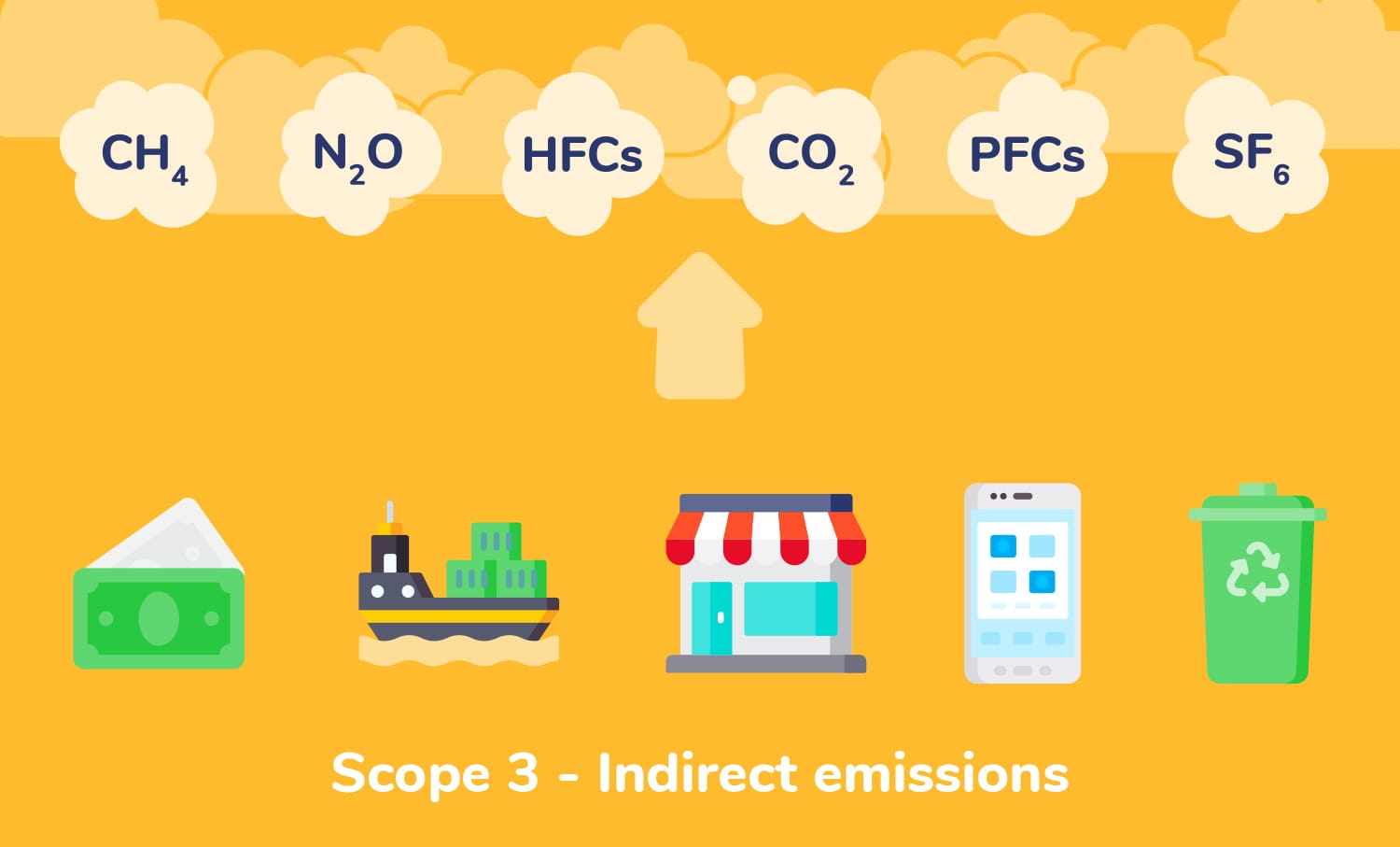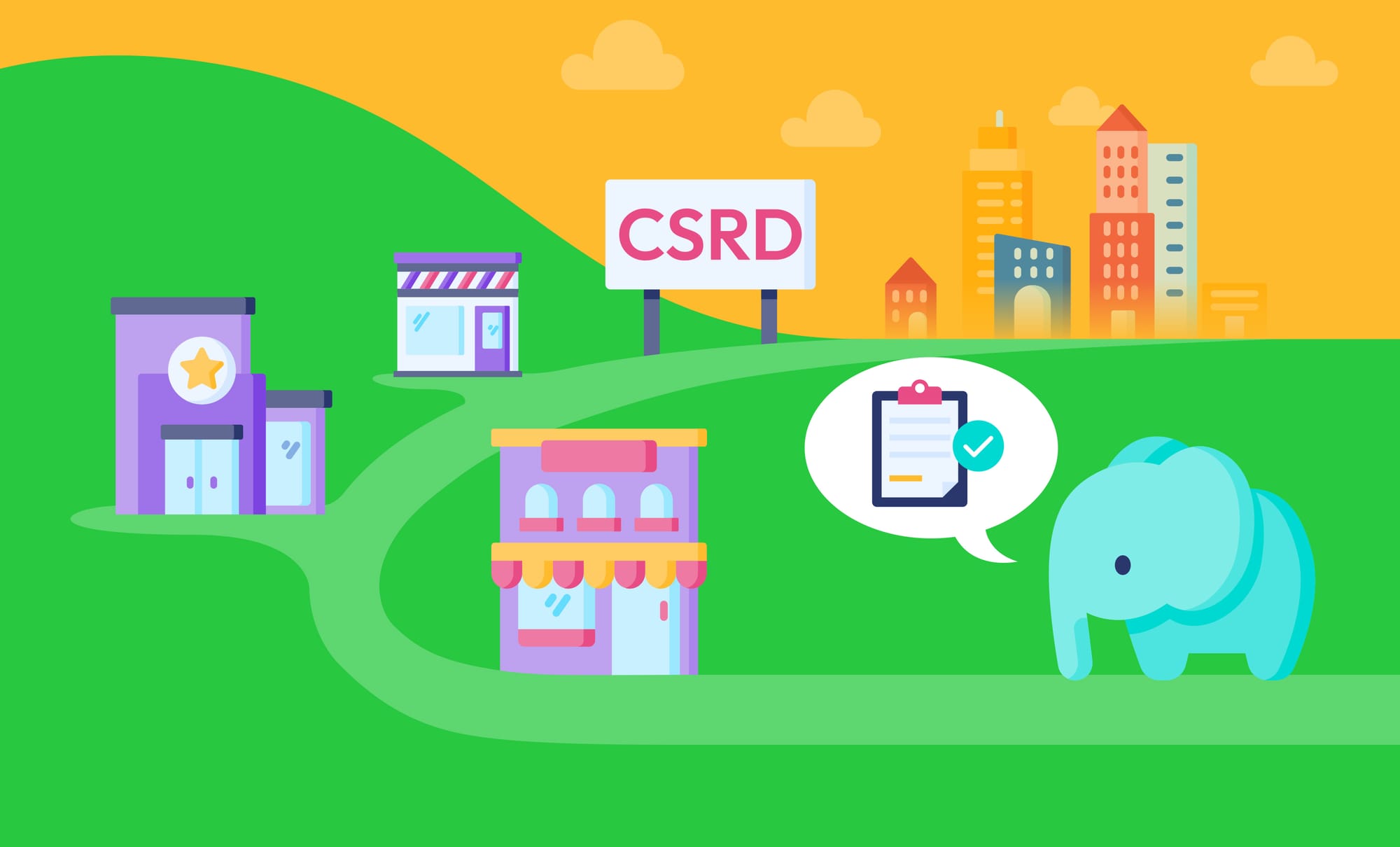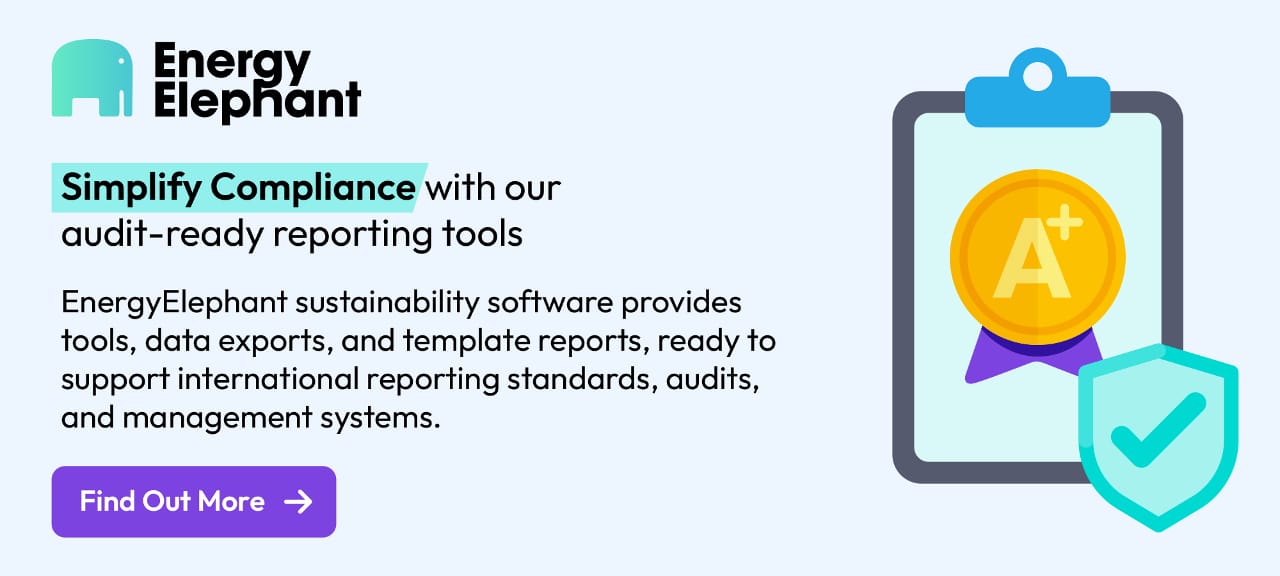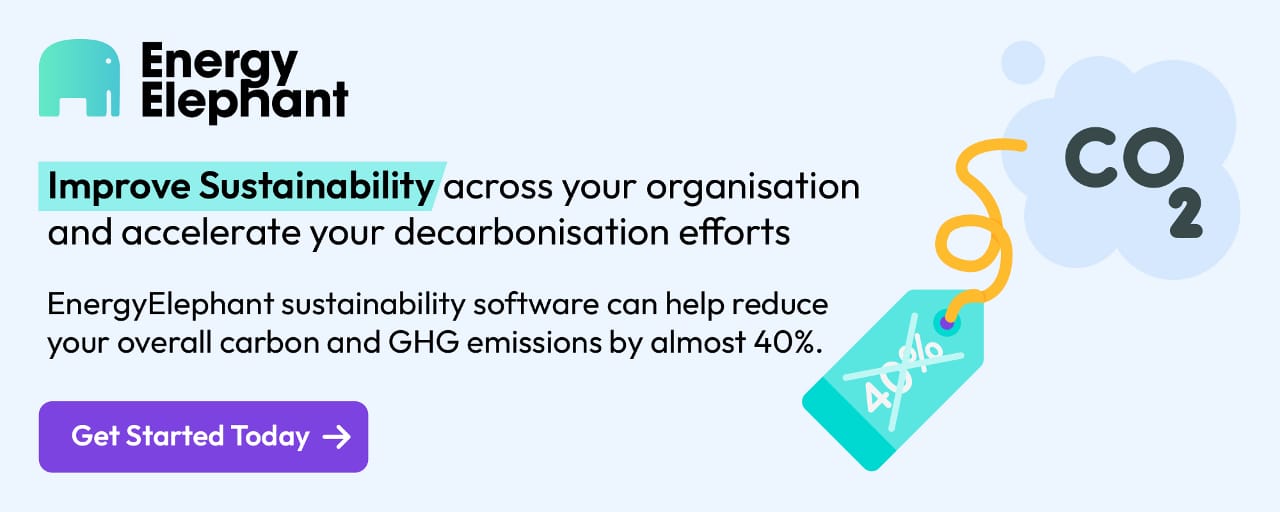Scope 3: The elephant in the boardroom
A practical guide to decarbonising your supply chain. Learn how to measure, manage, and report value chain emissions, engage suppliers, set science-based targets, and turn Scope 3 data into a business advantage.

For years, Scope 3 has been the elephant in the boardroom – simply seen as too big, too complex, and too far beyond an organisation’s direct control.
But that is changing fast.
Regulators are demanding visibility. Investors are asking sharper questions. Customers are choosing transparency. And organisations that once treated Scope 3 as a compliance checkbox are now realising it’s also one of their biggest opportunities for climate impact and a competitive advantage.
In this article, we start by explaining why Scope 3 matters, how to set accurate targets, the limitations of traditional spreadsheets, and how sustainability software can streamline the carbon data management process.
Next, we dive into supplier engagement, discussing the shift from command-and-control to collaboration, and how digital platforms can facilitate data sharing and impact.
We then outline key decarbonisation strategies, including how to identify high-impact levers, and integrate carbon criteria into procurement decisions.
Finally, we guide you on how to effectively communicate your progress, avoid greenwashing, and turn your sustainability efforts into a compelling brand story for customers and other stakeholders.

1. Why Scope 3 matters
Corporate climate leadership requires a complete inventory across all three scopes of greenhouse gas (GHG) emissions.
These include:
- Scope 1: Direct emissions from assets the organisation owns or controls (e.g. company vehicles, boilers, furnaces)
- Scope 2: Indirect emissions from purchased energy (electricity, heating, cooling, steam)
- Scope 3: All other indirect emissions from the value chain, both upstream (suppliers, logistics, capital goods) and downstream (product use, disposal, investments)
In a June 2024 report published by CDP and Boston Consulting Group, corporates revealed that, on average, their supply chain emissions are 26 times higher than their operational emissions. Despite this disproportionate scale, of all the organisations disclosing to CDP, only 15% had set Scope 3 emissions reduction targets.
There is also growing recognition that avoided emissions are a critical lever for accelerated, system-wide decarbonisation at a global level. We discuss this new voluntary metric in depth in our recent article, Scope 4: A critical piece of the net-zero puzzle.
Strategic advantages of Scope 3 measuring & reporting
Tackling Scope 3 offers not only some of the greatest potential for climate impact, but also a strong business case – investor confidence, reputational value, lower operating costs, greater regulatory compliance, higher valuations, increased revenues, improved attraction and retention of talent, and tax savings.
While most organisations know they need to tackle Scope 3, execution remains the biggest hurdle, especially as it sits outside of their direct control. Measuring indirect emissions means dealing with incomplete supplier data, complex supply chains, incompatible systems, and widely varying levels of maturity across geographic regions and industries.
An October 2025 report produced by the MIT Sustainable Supply Chain Lab showed that ~70% of sustainability leads cited supplier data availability as their top challenge.
Where to start when supplier data is missing
The GHG Protocol's Technical Guidance for Calculating Scope 3 Emissions encourages a ‘best available data’ approach, improving accuracy year by year.
The key is progress, not perfection.
Early mapping builds the foundation for credible reduction targets later.
Simple steps to get started:
- Map your value chain: Identify where emissions are likely to be concentrated using spend, procurement, and logistics data; even basic financial data can surface high-impact categories
- Use secondary data initially: Industry averages, emissions factors, and proxy data can fill early gaps; as suppliers engage, you can layer in primary activity data for accuracy
- Prioritise material categories: Focus first on the top 3–5 categories likely to represent most of your emissions (including flights, waste, and water)
Which framework to follow
The GHG Protocol's Corporate Value Chain (Scope 3) Accounting and Reporting Standard is a good place to start, as it underpins most global reporting frameworks, including SBTi, CDP, and CSRD.
GHG Protocol
- Purpose: Defines how to measure and categorise Scope 3 emissions (15 categories)
- Why it matters for Scope 3: The foundation for nearly all other frameworks
- Note: In September 2025, the GHG Protocol and International Organisation for Standardisation (ISO) announced a new strategic partnership, to align and merge parts of their respective carbon accounting frameworks and deliver a unified global framework for GHG emissions quantification and reporting
SBTi (Science Based Targets initiative)
- Purpose: Provides science-based target validation
- Why it matters for Scope 3: Mandates inclusion of Scope 3 when it makes up >40% of total footprint
CDP (Carbon Disclosure Project)
- Purpose: Global voluntary disclosure system
- Why it matters for Scope 3: Encourages transparency and supplier engagement across value chains
CSRD (Corporate Sustainability Reporting Directive)
- Purpose: EU regulation mandating sustainability disclosures from 2025
- Why it matters for Scope 3: Requires organisations to disclose Scope 3 emissions, methodologies, and data quality
GHG Protocol defines how to measure, SBTi defines how ambitious your targets must be, while CDP and CSRD define what to disclose.

Setting science-based targets for Scope 3
The SBTi requires organisations to include Scope 3 if it accounts for more than 40% of total emissions – which it almost always does.
To be credible:
- Use your initial baseline to set near-term (5–10 year) targets
- Commit to supplier engagement targets (e.g. percentage of spend covered by suppliers with science-based targets)
- Link reduction actions to tangible investments – procurement criteria, low-carbon materials, logistics optimisation, or renewable supply chain energy
What gets measured can be managed – but only when the measurement system itself is fit for purpose.
How accurate does Scope 3 data need to be
Accuracy expectations depend on the context – but transparency matters more than perfection. Regulators such as those under CSRD expect organisations to disclose their data sources, assumptions, and levels of uncertainty, rather than claiming false precision.
In practice, you should:
- Start with estimates, document methods clearly, and explain improvement plans
- Replace averages with supplier-specific data as relationships mature
- Use activity-based data (kWh, km, tonnes) over spend-based data where possible
Why spreadsheets don't cut the mustard
An alarming ~79% of organisations still rely on spreadsheets to manage their Scope 3 data. While this approach might work for small pilot projects, it quickly breaks down as data volumes grow because the tool itself can’t keep pace with the complexity of multi-tier supply chains.
Main risks of spreadsheet-based carbon data management:
- High error rates and limited auditability
- No traceability or integration with procurement systems
- Difficulty tracking data versions and changes over time
- Poor scalability and lack of collaboration tools
How sustainability management software can help
To close the Scope 3 data gap, organisations should move from fragmented spreadsheets to integrated systems, from estimates to traceability, and from compliance reporting to continuous improvement. That’s how Scope 3 stops being a compliance headache – and starts becoming a competitive advantage.
A fit-for-purpose platform can change the game by providing integrated data pipelines, automated calculations, and instant insights. It also makes it easier to run ‘what-if’ scenarios (e.g. modelling the impact of switching suppliers, transport modes, or materials).
Compared to spreadsheets, an all-in-one system increases data quality, enables real-time insights, and creates a single source of truth for your entire organisation (removing lots of headaches for managers in between).

2. Supplier engagement
Large organisations typically have more resources – technical, financial, and human – to meet sustainability objectives. Smaller suppliers, often in the early tiers of the chain, don’t share that advantage. Many lack the tools, resources, or capacity to collect detailed emissions data, or implement decarbonisation projects.
Smaller suppliers are far removed from the buyers setting climate goals, and without incentives or support, they simply can’t (or won't) keep up.
This imbalance leads to a broken system: big organisations push requirements downstream (more forms, more data, more audits) instead of building partnerships that generate mutual value. The result is fatigue, frustration, and ultimately – failure to meet Scope 3 targets.
From command-&-control to collaboration
To make progress, organisations must replace the ‘compliance checklist’ mindset with one built on collaboration, capacity-building, and co-benefits. This approach turns supplier reporting from a burden into a benefit.
The World Resources Institute (WRI) identifies three guiding questions for designing people-first, resilient supply chains:
1. Who is impacted? Map beyond Tier 1 suppliers:
- Understand the real people (e.g. factory workers, smallholder farmers, logistics operators) affected by your sustainability demands
- Use mapping tools and data platforms to identify ‘pain points’ in your extended supply chain
2. What’s in it for them? Create tangible incentives:
- Offer access to training, technical support, or cost-sharing for emissions reduction projects
- Replace one-way audits with two-way collaboration – send 'extension agents', not compliance auditors; suppliers want to keep customers happy, so relationships matter
3. Where can we invest for mutual benefit? Co-create value:
- Test innovative contracting models (e.g. shared savings agreements, bonus mechanisms, or supplier finance for energy upgrades)
- Integrate sustainability management software that allows secure, role-based data sharing – suppliers input their data, retain confidentiality, and receive insights in return
Collaboration succeeds when suppliers feel they’re partners, not data sources.
How digital platforms enable collaboration
The same tools that simplify Scope 3 reporting can also build trust and partnership when used strategically. Organisations that embrace a collaborative approach report stronger relationships, more accurate data, and faster progress on Scope 3 targets.
This could include:
- Shared dashboards: Both buyer and supplier see the same sustainability metrics, improving alignment
- Role-based data access: Suppliers control what they share, addressing concerns about confidentiality and commercial sensitivity
- Integrated onboarding: Include sustainability expectations, data templates, and simple upload workflows in supplier onboarding
Prioritising supplier engagement
Not all suppliers are equal in their emissions impact or capacity to act. Focus first where engagement yields the greatest return. By starting with these groups to build early wins and case studies, these stories will become powerful internal motivators – especially for finance and operations teams that need proof of impact before scaling up:
- High-emissions categories: Materials, logistics, or product use phases
- Strategic suppliers: Those critical to operations or brand reputation
- Willing innovators: Smaller partners ready to experiment or pilot solutions
From data collection to shared impact
Many of the most effective corporate sustainability programmes today share a common feature: they treat supplier data as a shared asset, not a compliance form.
By inviting suppliers into the same data environment – rather than extracting data from them – organisations create a feedback loop. Suppliers see how their actions affect the buyer’s carbon footprint and gain recognition for improvements. It turns emissions transparency into an incentive, not an obligation.
3. Decarbonisation strategy
Once you’ve mapped your emissions and started engaging suppliers, the next step is to translate insights into impact.
This is where strategy becomes execution – and where most organisations struggle.
Globally, the biggest obstacles to Scope 3 reduction aren’t technical, but economic and organisational: lack of clear return on investment (ROI), high costs, and limited influence over suppliers.
But the same research also shows that organisations that quantify and communicate the business benefits of decarbonisation – cost savings, efficiency gains, risk mitigation – are far more likely to act.
Identifying high-impact levers
The GHG Protocol's 15 Scope 3 categories provide a roadmap, but it's important to remember that the relevance of Scope 3 categories by sector will differ.
Focus where you can move the needle fastest. Start by pairing emissions magnitude with influence level – the sweet spot where your organisation can drive measurable change through procurement, product design, or collaboration.
Typical high-impact levers include:
- Purchased Goods and Services: Optimise material sourcing, switch to low-carbon or recycled inputs
- Transportation and Distribution: Consolidate loads, optimise routes, shift to rail/shipping versus flights or use low-emission vehicles
- Use of Sold Products: Redesign products for energy efficiency or longer lifespans
- Waste Management and Circularity: Close material loops through reuse and re-manufacturing
Model the ROI of Scope 3 reduction
The idea that sustainability and profitability are at odds is outdated. According to global studies, operational efficiency strategies such as route optimisation, load consolidation, and energy management deliver both immediate cost savings and emissions reductions. It is not an 'either/or' relationship.
To win board-level support, show Scope 3 actions through a financial lens:
- Avoided costs: Energy savings, reduced material waste, lower logistics expenses
- Revenue upside: Customer preference for sustainable products, access to green finance, and premium brand positioning
- Risk mitigation: Compliance with CSRD, reduced exposure to carbon pricing and supply chain disruptions
Partner for shared reductions
No organisation can decarbonise its value chain alone. Collaborations create economies of scale – and credibility with investors and regulators. The most effective Scope 3 strategies are collective by design.
Examples include:
- Supplier partnerships: Co-fund energy-efficiency upgrades or renewable installations
- Industry collaborations: Share methodologies or create pooled data platforms to reduce reporting burden
- Logistics alliances: Join low-carbon freight networks or consolidate deliveries with peers
It's also important to celebrate successes through entering awards and publicising joint successes both internally and externally.
Integrate carbon criteria into procurement
Integrating carbon criteria into purchasing decisions sends a powerful signal through your supply chain.
Tactics to use in the procurement process:
- Include emissions disclosure requirements in tenders and RFPs
- Award contracts based on carbon-intensity metrics as well as price
- Offer longer-term contracts to suppliers investing in decarbonisation

4. Communicating progress
Communicating your Scope 3 progress isn’t just about compliance – it’s about building credibility with your investors, regulators, and customers. Done well, it can turn a mandatory disclosure into a brand-defining leadership moment.
Real credibility comes from being clear about what you know, what you don’t, and how you will close the gap. If you can clearly explain where your data comes from, what assumptions you’ve made, and how you plan to improve accuracy, regulators and investors will reward your honesty.
The best sustainability reports read like progress stories, not press releases.
From reporting to storytelling
With generative AI summarising and surfacing sustainability information across the web, well-structured narratives are now indexed, summarised, and amplified – meaning clear, honest communication reaches far beyond your annual report.
Your Scope 3 report should do three things:
- Inform: Provide clear, verified data aligned with recognised standards
- Inspire: Show progress and commitment with real-world examples
- Invite: Bring your stakeholders (suppliers, customers, investors) on the journey with you
Practical ways to achieve this include:
- Show, don't tell: Pair data tables with case studies of supplier collaboration or circular economy initiatives
- Use visuals: Include dashboards, infographics, and charts (e.g. Sankey diagrams) to illustrate how emissions flow through your value chain
- Include a ‘next steps’ roadmap: Make it clear your journey is ongoing, not complete

Avoid greenwashing
As scrutiny grows, so does the risk of being accused of over-claiming progress.
Common pitfalls include:
- Publishing high-level targets without supporting data
- Reporting reductions that are actually due to divestments, not decarbonisation
- Using inconsistent baselines or opaque methodologies
To avoid these, align your communication with the same data integrity principles used in financial reporting: audit trails, documented methods, and third-party verification where possible.
Turn progress into brand value
By embedding climate responsibility in daily operations and aligning your story with credible data, Scope 3 is no longer just an ESG exercise – it becomes a proof point of leadership, turning your sustainability journey into a trust dividend.
Credibility compounds. Each year of consistent, transparent reporting builds a foundation of trust that marketing simply cannot buy.
